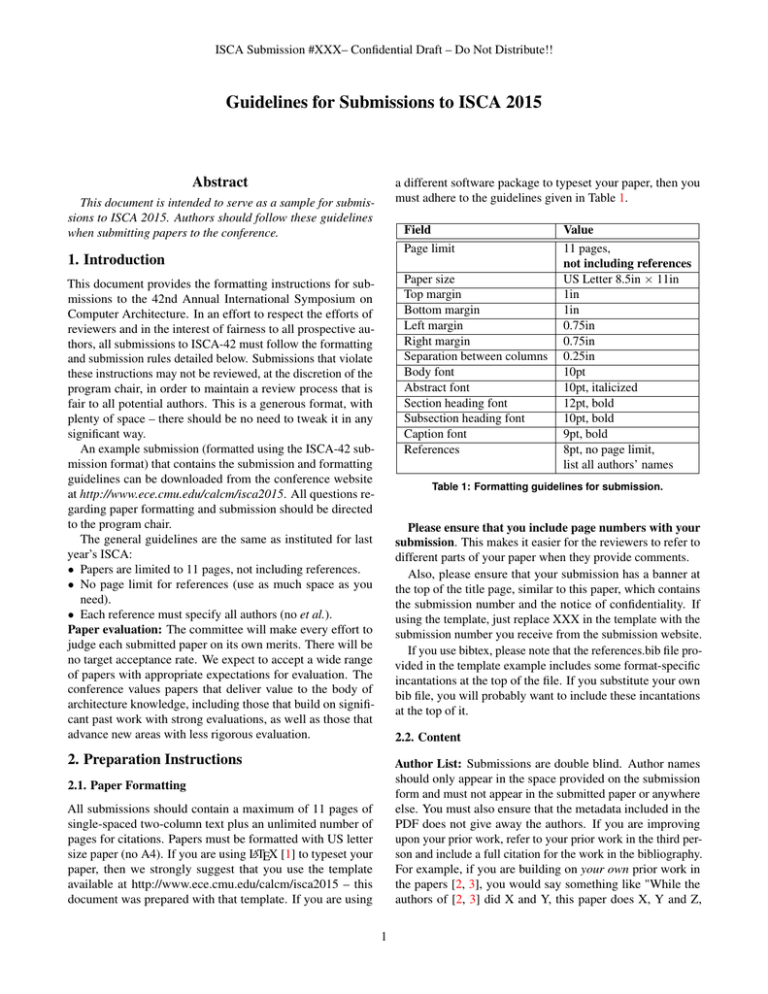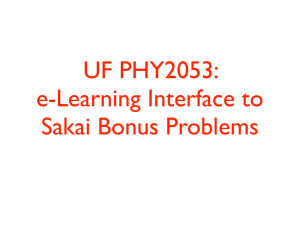Guidelines for Submissions to ISCA 2015 Abstract
advertisement

ISCA Submission #XXX– Confidential Draft – Do Not Distribute!! Guidelines for Submissions to ISCA 2015 Abstract a different software package to typeset your paper, then you must adhere to the guidelines given in Table 1. This document is intended to serve as a sample for submissions to ISCA 2015. Authors should follow these guidelines when submitting papers to the conference. Field Page limit 1. Introduction Paper size Top margin Bottom margin Left margin Right margin Separation between columns Body font Abstract font Section heading font Subsection heading font Caption font References This document provides the formatting instructions for submissions to the 42nd Annual International Symposium on Computer Architecture. In an effort to respect the efforts of reviewers and in the interest of fairness to all prospective authors, all submissions to ISCA-42 must follow the formatting and submission rules detailed below. Submissions that violate these instructions may not be reviewed, at the discretion of the program chair, in order to maintain a review process that is fair to all potential authors. This is a generous format, with plenty of space – there should be no need to tweak it in any significant way. An example submission (formatted using the ISCA-42 submission format) that contains the submission and formatting guidelines can be downloaded from the conference website at http://www.ece.cmu.edu/calcm/isca2015. All questions regarding paper formatting and submission should be directed to the program chair. The general guidelines are the same as instituted for last year’s ISCA: • Papers are limited to 11 pages, not including references. • No page limit for references (use as much space as you need). • Each reference must specify all authors (no et al.). Paper evaluation: The committee will make every effort to judge each submitted paper on its own merits. There will be no target acceptance rate. We expect to accept a wide range of papers with appropriate expectations for evaluation. The conference values papers that deliver value to the body of architecture knowledge, including those that build on significant past work with strong evaluations, as well as those that advance new areas with less rigorous evaluation. Value 11 pages, not including references US Letter 8.5in × 11in 1in 1in 0.75in 0.75in 0.25in 10pt 10pt, italicized 12pt, bold 10pt, bold 9pt, bold 8pt, no page limit, list all authors’ names Table 1: Formatting guidelines for submission. Please ensure that you include page numbers with your submission. This makes it easier for the reviewers to refer to different parts of your paper when they provide comments. Also, please ensure that your submission has a banner at the top of the title page, similar to this paper, which contains the submission number and the notice of confidentiality. If using the template, just replace XXX in the template with the submission number you receive from the submission website. If you use bibtex, please note that the references.bib file provided in the template example includes some format-specific incantations at the top of the file. If you substitute your own bib file, you will probably want to include these incantations at the top of it. 2.2. Content 2. Preparation Instructions Author List: Submissions are double blind. Author names should only appear in the space provided on the submission form and must not appear in the submitted paper or anywhere else. You must also ensure that the metadata included in the PDF does not give away the authors. If you are improving upon your prior work, refer to your prior work in the third person and include a full citation for the work in the bibliography. For example, if you are building on your own prior work in the papers [2, 3], you would say something like "While the authors of [2, 3] did X and Y, this paper does X, Y and Z, 2.1. Paper Formatting All submissions should contain a maximum of 11 pages of single-spaced two-column text plus an unlimited number of pages for citations. Papers must be formatted with US letter size paper (no A4). If you are using LATEX [1] to typeset your paper, then we strongly suggest that you use the template available at http://www.ece.cmu.edu/calcm/isca2015 – this document was prepared with that template. If you are using 1 and is therefore much better." Do NOT omit or anonymize references for blind review. Figures and Tables: Ensure that the figures and tables are legible. Please also ensure that you refer to your figures in the main text. The proceedings will be printed in gray-scale, and many reviewers print the papers in gray-scale. Therefore, if you must use colors for your figures, ensure that the different colors are highly distinguishable in gray-scale. If a figure is not easily understandable in gray-scale, then assume it will not be understood by the reviewers. In many cases, it is better to just prepare your documents without color. Main Body: Avoid bad page or column breaks in your main text, i.e., last line of a paragraph at the top of a column or first line of a paragraph at the end of a column. If you begin a new section or sub-section near the end of a column, ensure that you have at least 2 lines of body text on the same column. Citations: Please list all authors of every cited work in the references section and avoid using et al. The paper submission format allows an unlimited number of pages for citations, so there is no need to scrimp on space for them. You many exclude “service” collaborations like coauthoring an NSF workshop report or serving together on a program committee. 5. People who shared your primary institution in the last five years. Note that if either you or they have moved, there could be several institutions to consider. There may be others with whom you know a conflict of interest exists. However, you will need to justify this conflict of interest. Please be reasonable. For example, you cannot declare a conflict of interest with someone for the sole reason that they work in a similar area as your submitted paper. The program chair may contact co-authors to explain COIs whose origin is not clear. You must declare all conflicts with PC/ERC members as well as others with whom you have a conflict of interest. When in doubt, contact the program chair. 3.3. Concurrent Submissions and Resubmissions of Already Published Papers By submitting a manuscript to ISCA-42, the authors guarantee that the manuscript has not been previously published or accepted for publication in a substantially similar form in any conference or journal. The authors also guarantee that no paper that contains significant overlap with the contributions of the submitted paper is under review at another conference or journal, or a workshop with an archived proceedings, or will be submitted to one of them before the ISCA-42 author notification deadline. Violation of any of these conditions will lead to rejection. Extended versions of papers accepted to IEEE Computer Architecture Letters can be submitted to ISCA-42. If you are in doubt, contact the program chair. Finally, we also note that the ACM Plagiarism Policy (http://www.acm.org/publications/policies/plagiarism_policy) covers a range of ethical issues concerning the misrepresentation of other works or one’s own work. 3. Submission Instructions 3.1. Paper Authors Declare all the authors of the paper at time of submission. Addition/removal of authors once the paper is accepted will have to be approved by the program chair. The paper selection process is carefully run in a way that maximizes fairness by seeking to eliminate all conflicts of interest. Late changes to author lists can invalidate that process. 3.2. Declaring Conflicts of Interest Authors must register all of their conflicts into the paper submission site. Conflicts are needed to resolve assignment of reviewers. Please get the conflicts right. You have a week between the registration of the paper and final submission – there is no need to do the conflicts in a rush at the last second. If a paper is found to have an undeclared conflict that causes a problem OR if a paper is found to declare false conflicts in order to abuse or “game” the review system, the paper may be rejected. Please declare a conflict of interest (COI) if any of the following exist for any author of a paper: 1. Your Ph.D. advisor and Ph.D. students forever. 2. Family relations by blood or marriage forever (if they might be potential reviewers). 3. Other past or current advisors. 4. People with whom you collaborated in the last five years. Collaborators include: • Co-authors on an accepted/rejected/pending research paper. • Co-PIs on an accepted/rejected/pending grant. • Those who are funders (decision-makers) regarding your research grants, and researchers whom you fund. References [1] L. Lamport, LATEX: A Document Preparation System, 2nd ed. Reading, Massachusetts: Addison-Wesley, 1994. [2] F. Lastname1 and F. Lastname2, “A Nice Paper To Cite,” in International Symposium on Computer Architecture, July 2000, pp. 200–211. [3] F. Lastname1, F. Lastname2, F. Lastname3, and F. Lastname4, “A Second Nice Paper To Cite,” in International Symposium on Computer Architecture, May 2001, pp. 12–22. 2
![Abstract Submission form – University of Kent [4]](http://s3.studylib.net/store/data/006978975_1-efbec71d82067924b8838e608fcd0114-300x300.png)






